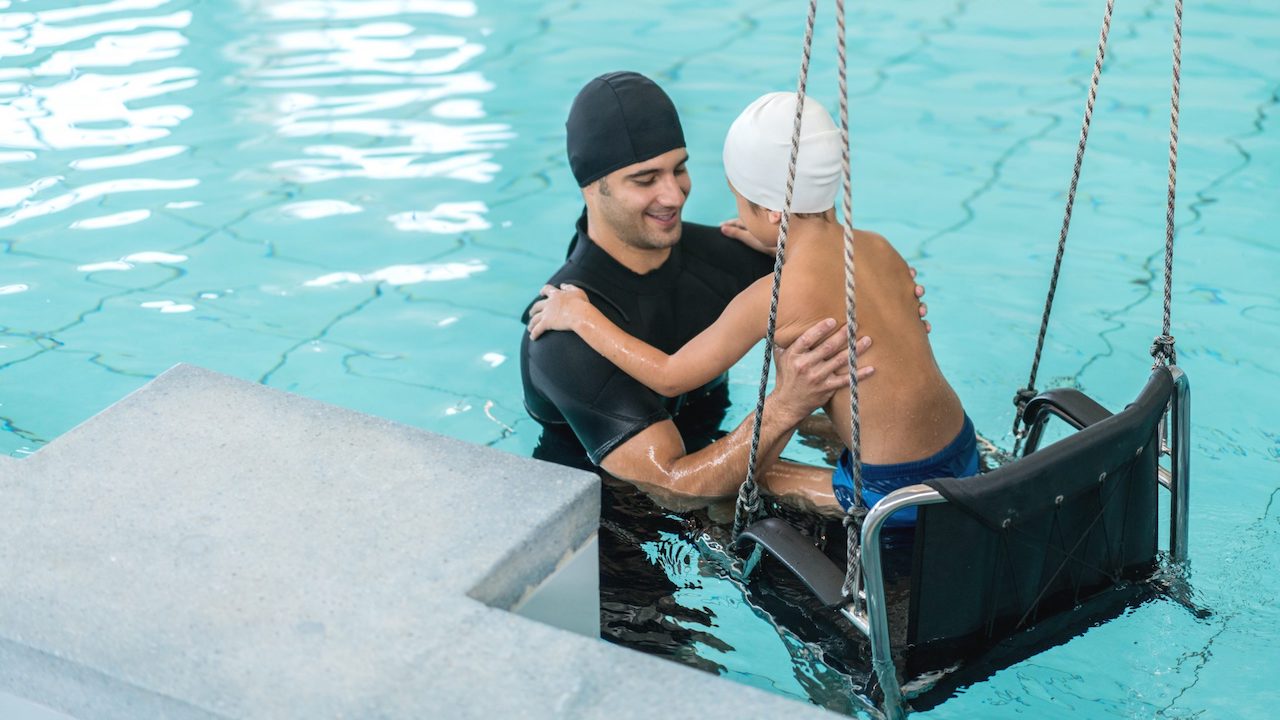

Are you looking for an innovative way to help people in need of rehabilitation? Aquatic therapy may just be the answer you’ve been searching for! This revolutionary form of therapy has been known to be an absolute lifesaver, quite literally transforming lives in a single session.
Aquatic therapy has been used to help people of all ages and with a variety of conditions, offering a range of benefits that cannot be matched. In this article, you will learn all about the potential of aquatic therapy and how it can be used to help those in need of rehabilitation.
You may be wondering what aquatic physical therapy is in the first place and how it can help you in your journey of healing.
Aquatic therapy is a form of physical therapy exercise performed in a pool, typically with a certified physical therapist. The pool size and water temperature are tailored to your specific needs, allowing you to move through the water with ease and comfort.
This form of therapy helps to reduce pain and swelling, improve joint range of motion, and increase strength and flexibility. It is particularly beneficial for improving balance and coordination, as the buoyancy of the water helps to reduce stress on the joints and muscles.
Furthermore, the warm water and natural resistance of water can help to relax the muscles and relieve tension. It can also be used to help treat sports injuries, chronic pain, and a variety of other conditions.
In addition to its physical benefits, it can be an enjoyable and calming experience. The warm water, gentle movements, and soothing environment can help to reduce stress, promote relaxation, and provide a sense of well-being.
Soaking in the water, you can feel the warmth of the pool hug your body like a comforting embrace, allowing your muscles to relax and your body to heal.
Aquatic therapy is a therapeutic technique used to help those in need of rehabilitation gain strength and mobility through the power of water. It’s a form of physical therapy that utilizes the properties of the water to provide a safe and supportive environment for healing.
 Photo Credit: ArtHouse Studio
Photo Credit: ArtHouse Studio
It works by using the natural buoyancy, resistance, and temperature control of the water to help patients move and strengthen their muscles, joints, and ligaments. A trained aquatic therapist will use a variety of waterproofing techniques to help the patient move more freely and comfortably in the water.
This includes the use of flotation devices, specialized pool equipment, and other tools to help the patient move in the water. The therapist will also adjust the temperature of the pool to accommodate the needs of the patient, including using cold water to reduce inflammation and swelling.
By using the properties of the water and the guidance of a trained therapist, patients can benefit from the healing power of aquatic therapy and gain strength and mobility.
With the help of a trained specialist, aquatic therapy can be used to improve your strength and mobility, while reducing inflammation and swelling. Because of the properties of water, such as the added buoyancy that water provides, exercise intensity can be tailored to the individual’s needs. It also helps to improve joint range of motion and flexibility.
It can be used to treat a variety of conditions, including arthritis, tendonitis, post-operative rehabilitation, fibromyalgia, sports injuries, chronic pain, and other musculoskeletal disorders. It can also be useful for those who have difficulty with weight-bearing exercise, as well as those who require neurological rehabilitation.
This type of therapy can be used to increase strength and endurance, improve balance, and reduce stress. It can also provide a safe and gentle way to improve range of motion, flexibility, and coordination. The water temperature helps to reduce inflammation and swelling, which makes it easier to move.
Immersing yourself in the healing powers of water can be like a breath of fresh air, providing multiple advantages that can help you manage pain and discomfort.
Aquatic therapy is an effective form of rehabilitation that uses the buoyancy and hydrostatic pressure of water to reduce pain and increase muscle flexibility. The water’s natural environment provides support and resistance, allowing for more activity with less strain.
 Photo Credit: Andrea Piacquadio
Photo Credit: Andrea Piacquadio
Benefits of aquatic therapy include improved balance, coordination, strength, and flexibility. It can help alleviate pain and swelling due to joint or muscle inflammation, thereby increasing mobility.
It can also help with managing stress, improving mental well-being, and promoting relaxation. Additionally, the warmth of the water helps reduce muscle tension, making it a great option for athletes who need quick recovery from strenuous activity.
Floating in the calming waters can give you a sense of relief and freedom, allowing you to reap the rewards of a range of physical and mental gains. Hydrotherapy is an effective form of treatment for those with physical limitations or disabilities, as it can provide the patient with low-impact activities in a supportive environment.
There are several types of aquatic therapy available, each offering unique benefits.
Hydrostatic pressure therapy, for example, provides support for the body, allowing the patient to move more freely and with less pain.
Buoyancy effects also offer an additional advantage by providing support for the body, allowing for a greater range of motion and improved coordination.
It can also be used to increase strength and reduce fatigue, as well as improve balance, coordination and flexibility. By providing a supportive environment, aquatic therapy can help those with physical limitations improve their health and well-being.
Now that you understand the different types of aquatic therapy, you may be wondering who can benefit from this form of rehabilitation.
Aquatic therapy can be beneficial for individuals of all ages, from elderly patients to children, and can help alleviate chronic pain, improve physical function and fitness, and even reduce stress.
 Photo Source: Cottonbro Studio
Photo Source: Cottonbro Studio
Elderly patients and individuals with chronic pain often find relief from it due to the reduced weight-bearing and buoyancy of the water. The warmth of the water helps relax the muscles, allowing them to move more freely and with less pain.
The water also provides gentle resistance, which is great for strengthening muscles and increasing range of motion without the risk of injury.
It can also be beneficial for those with neurological conditions such as stroke, cerebral palsy, Parkinson’s disease, and multiple sclerosis. By taking part in such type of therapy, these individuals can improve their balance, coordination, and strength, as well as their overall well-being.
If you’re looking to improve your physical and mental well-being, seeking out aquatic therapy may be a great way to start. It’s important to seek advice from a qualified healthcare provider or physical therapist to determine if it is right for you. You should also discuss your long-term goals before beginning a program.
It can be beneficial for those with a wide range of injuries or physical conditions, including chronic pain, joint stiffness, and mobility issues. It can also be helpful for people recovering from surgery, or with conditions such as Parkinson’s disease or fibromyalgia.
It can be used as a primary form of treatment or as an adjunct to other treatments. It is important to consult your doctor or physical therapist before beginning the therapy water to ensure that it is safe and appropriate for your condition.
You can maximize your safety and reap the rewards of exercise with aquatic-based rehabilitation, all while taking the necessary precautions.
 Photo Credit: Agung Pandit Wiguna
Photo Credit: Agung Pandit Wiguna
When engaging in aquatic therapy, there are a few safety considerations to keep in mind:
Aquatic therapy is a safe and effective form of exercise when taken with the necessary precautions. By monitoring water temperature, assessing the pool environment, utilizing proper equipment, wearing appropriate swimwear, and seeking professional guidance, you can enjoy its benefits in a safe and comfortable environment.
You should always take safety precautions before beginning any type of therapy, including aquatic therapy.
Before starting, it’s important to stretch and warm up your muscles. You should also make sure the pool temperature is comfortable for you. Additionally, it’s important to check the depth of the water and make sure the pool is equipped with proper safety equipment.
Taking these safety precautions can help you get the most out of your aquatic therapy session.
You’ve heard about aquatic therapy for rehabilitation, and you’re wondering how soon you can expect to see results.
Good news! With the right water temperature and muscle-strengthening exercises, you can begin to see gains in as little as a few weeks.
What’s even better is that the progress you make can be tailored to your individual needs and goals. With the right guidance, you can be confident that you’ll soon start to feel the benefits of aquatic therapy.
When it comes to aquatic therapy, there are some risks associated with it.
The water temperature and pool depth must be carefully monitored to ensure an optimal environment for the patient. This is important as a too-hot or too-cold pool can be uncomfortable and cause injury.
If the pool is too deep, it can be dangerous if the patient is not an experienced swimmer. Additionally, pool chemicals must be monitored to ensure they’re not too strong, as this can cause skin irritation or allergic reactions.
Taking these precautions can help reduce any risks associated with aquatic therapy.
You may be wondering if aquatic therapy is covered by insurance.
While the cost implications can vary, many insurance companies recognize the benefits of aquatic therapy and will cover some or all of the cost. However, it’s important to ensure that the pool conditions are appropriate for the type of therapy being offered.
After all, the old adage “prevention is better than cure” applies in this case too. Knowing what’s covered by insurance can help you make an informed decision and ensure that you’re getting the most out of your aquatic therapy sessions.
Attending aquatic therapy sessions regularly is an important part of the rehabilitation process. Your healthcare provider will determine the exercise intensity and water temperature you experience in each session, as well as how often you should attend.
Generally, you should attend sessions two to three times a week to get the full benefits of aquatic therapy. As you progress and your needs change, your healthcare provider may adjust the frequency of your sessions.
You can see that aquatic therapy is an effective and beneficial form of rehabilitation for a variety of conditions. It can help improve physical, mental, and emotional well-being, and it’s a safe and enjoyable form of treatment.
As the old adage goes, “prevention is better than cure,” and aquatic therapy is a great way to prevent injury and improve your overall health. With the right guidance and support, aquatic therapy can help you get back on your feet and live a healthier life.
As with any type of therapy, it’s important to consult with your doctor to determine if aquatic therapy is right for you.
There are no results matching your search.
Reset